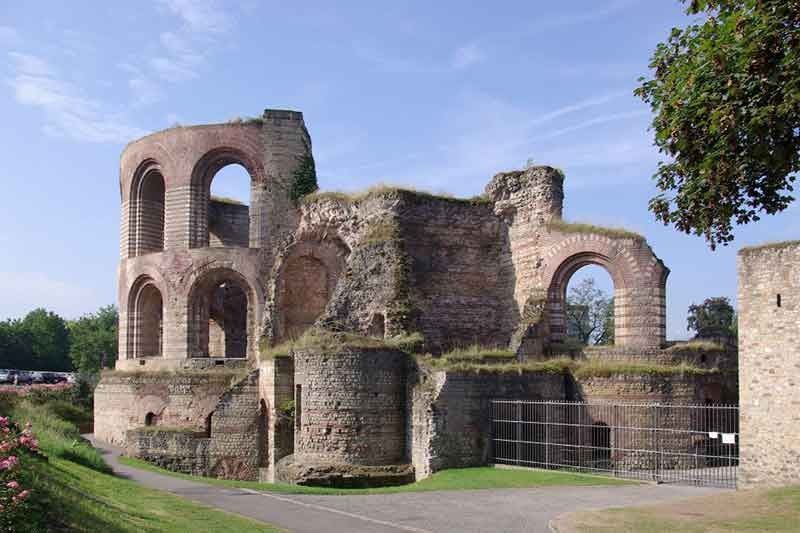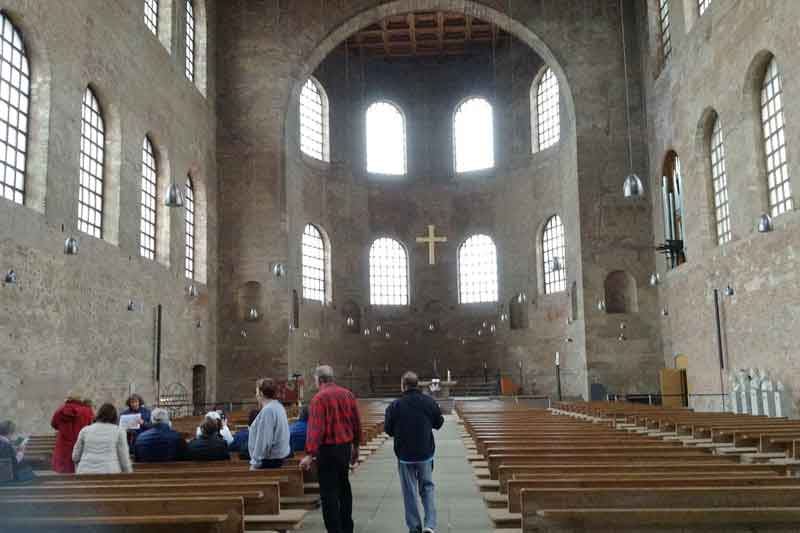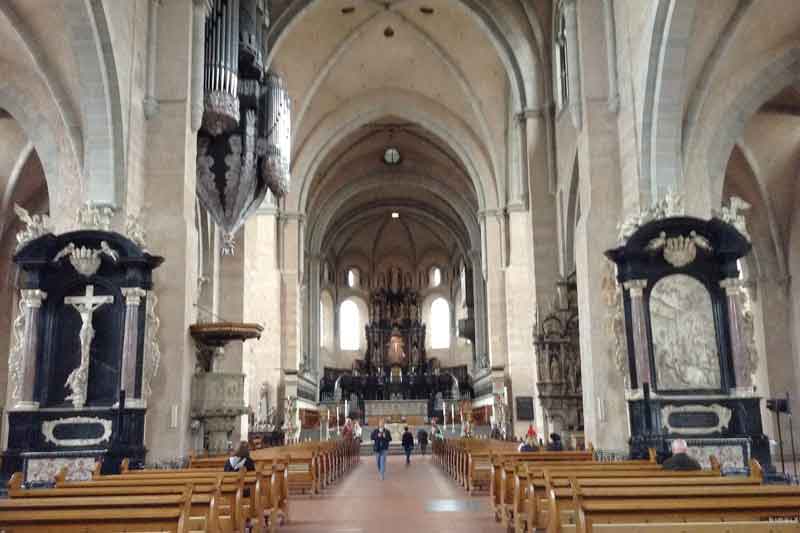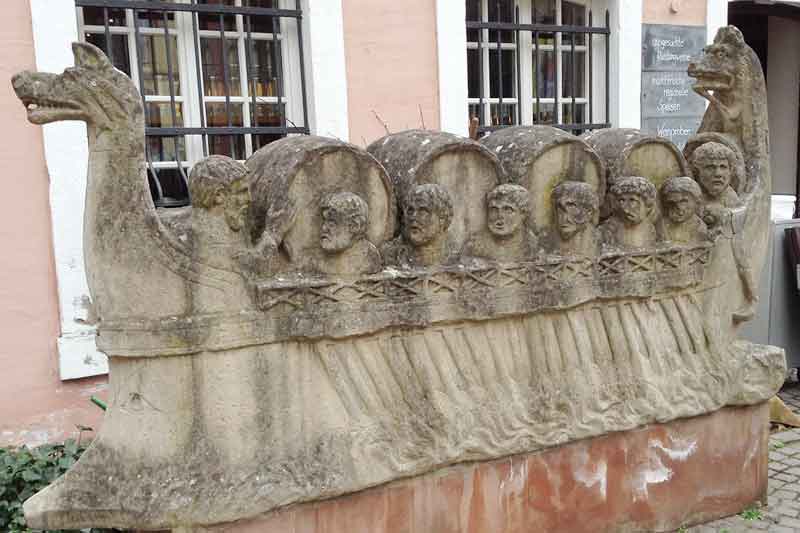Trier: Rome in Germany

MANILA, Philippines — Known as the birthplace of the German philosopher Karl Marx, Trier, Germany’s oldest city and dubbed as the Pearl of the Moselle, sits in a valley replete with valuable outdoor ruins and priceless reminders of ancient Rome.
Our first destination was the immense Basilica Konstantin, also known as the Aula Palatina, constructed in the 4th century by Emperor Constantine the Great, the first Roman ruler to convert to Christianity.
The red brick interiors were rather simple and austere. Ravaged in World War II, upon reconstruction the former sacred images and religious icons were not replaced, thus leaving the walls exposed and bare.
Right beside was the Electoral Palace, with its impressive façade with touches of gold leaf, arguably the most beautiful Rococo chateau of its era. An elegant staircase keyed in visitors to the lavish lifestyle of the revered Electors and Archbishops, while the long corridors were filled with masterpieces from notable artists from other nations and territories.
A stroll through the adjacent Electoral Garden revealed two distinct landscaping philosophies: a portion partial to a French garden, with finely trimmed bushes bursting with blooms – only somewhat spoiled by a stern “Do Not Step” sign. Meanwhile, the English counterpart appeared to be whimsically arranged in ordered chaos to appear intentionally natural.

The rather stark interiors of the Basilica Konstantin.
On our visit, tulips were the main attractions. But the featured species changes according to the season. But no matter what variety of flower may be on display, it would always be dictated by the hues of red and yellow, the official colors of Trier.
Proudly standing along the pathways amidst the patches of greens and shrubs were a number of rather frivolous whitewashed statues by German sculptor Ferdinand Tietz (1708-1777).
The Porta Nigra, or Black Gate, the largest Roman portal north of the Alps and incidentally the symbol of the city, is the most aged structure of defense in all of Germany. Erected with huge grey sandstone blocks during the second century AD, this magnificent piece of architecture stands grandiosely flanked by two asymmetrical towers.
Though its exterior remains generally unchanged, touches of medieval influences may be noticed, courtesy of the faithful reconstruction efforts of the French emperor Napoleon Bonaparte (1769-1821).
Open all year-round, the Porta offers guided tours in the summer, where actors in full Roman Centurian regalia act as guides.
Behind some sparse remains of the medieval city walls are two iconic testimonies of Rome: the Trier Imperial Baths and the Trier Amphitheater.

The High Cathedral of Saint Peter in Trier is the most senior church in Germany.
The expansive and sophisticated hot and cold water complex, the largest outside of The Eternal City, became an integral part of daily life.
All possible self-care indulgences were practiced: full body massage, body hair removal and entire body scrubs with pumice stones. Our guide hinted that these invigorating bathing pools and relaxing quarters were often crisscrossed by naked citizens.
These basins had cement columns decorated with marble sand sculptures, which added a touch of worldliness, for the areas were not just utilized for bathing, but also for business and socializing, with pubs to drink at, tables to gamble on and pools to swim in. It was the undeniable forerunner of a country club with a modern spa.
A grassy slope by a rolling hill provided stark contrast to the gruesome past of the Trier Amphitheater, an arena where gladiators fought to their deaths – man against man, man against beast, beast against beast.
This place of carnage could fit some 20,000 hungry-for-action spectators shouting like madmen for blood and more blood. If you closed your eyes, you could even imagine the cheers and the jeers of onlookers from the past. And if all that was not enough, at other times, the theater was also used for public executions.
The site was well preserved, perhaps due to the absence of modern-day looters, out of respect for the victims of this brutal form of entertainment.

In full bloom: a magnolia tree and tulips in the official colors of red and yellow at the Electoral Garden.
These places have been a cornerstone of tradition and culture, that The Roman Monuments, together with the High Cathedral of Saint Peter and Church of Our Lady, have all been hailed as UNESCO World Heritage Sites.
Made of bricks and commissioned by Saint Agustine the Great (354-430 AD), the High Cathedral of Saint Peter has been rebuilt and re-embellished, in conformity to the styles of the period.
For instance, the guide pointed to Gothic vaults, Renaissance sculptures and Baroque side altars yet declared, “It is still a Romanesque church.”
The Baroque ceilings made our eyes pop, while the melodious sounds from the organ were absolutely worth listening to even if it was your second mass for the day.
We overheard some tourists whisper that the cathedral hosts a sizable collection of Christian artwork – the seamless robe of Jesus and one of the holy nails, the tunic and spike used in the crucifixion; the Egbert Shrine – portable altar which bears the sole of the sandal of Saint Andrew the Apostle; and the skull of Saint Helena, the mother of Emperor Constantine.

A sculpture showing workers carrying casks of wine.
The tallest clock tower of the church bears the inscription Nescitis Qva Hora Dominus Veniet, which translates to “You do not know what time the Lord is coming.”
A cloistered hallway connects to the Church of Our Lady, known as the Liebfrauenkirche, built from the foundations of an older structure during the Roman times and exhibits some of the earliest Gothic paintings, sculptures and stained glass panels in the country.
Our attention was called to its cruciform floor plan, with four portals and 12 altars in a circular pattern, representing the 12 tribes of Biblical Israel, 12 Apostles of Christ, 12 articles of the Apostle’s Creed and lastly to signify a 12-petaled rose used as a symbol of the Virgin Mary, the Rosa Mystica.
It was sheer joy to get lost in the town’s Central Marketplace, whose centerpoint was the gilded fountain, flanked by bakeries, where breads tasted like bread and not like pastries, cafés where you can almost swear you had the best cup of coffee, until you tried another one around the bend; restaurants where dishes are heaven-sent, cooked by the world’s greatest moms, and mom-and-pop shops where artisanal handicrafts overwhelm by the possibilities of what human hands are capable of, nested in homes which feature the fairytale half-timbered pattern.
As if a dream within a dream, Trier has been more than a continuous countdown of pleasant surprises. The preserved past has become a valuable modern-day relic, which solidified the city’s status as an eternal town – for its radiance has not gone away at all.


















